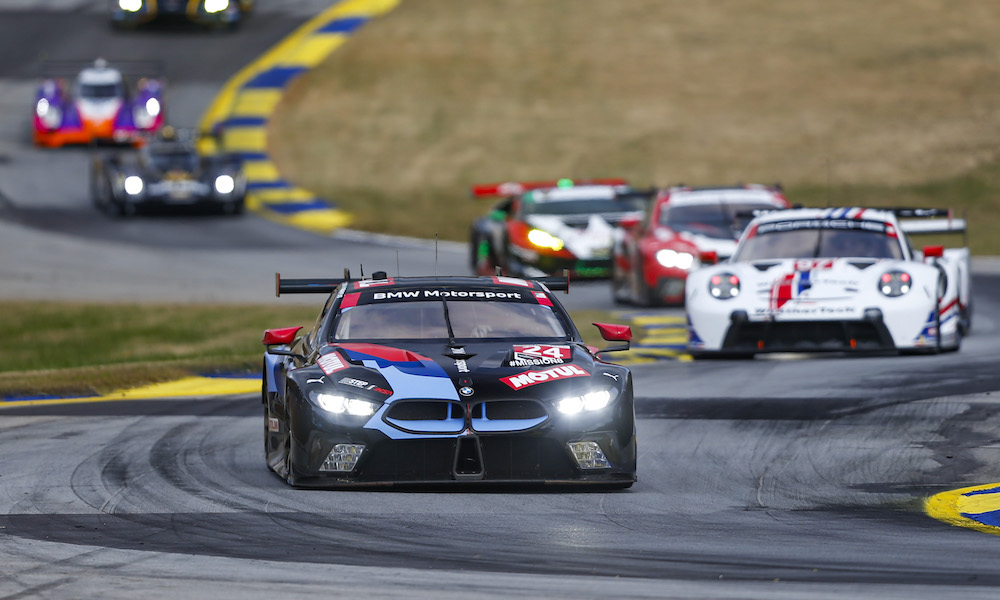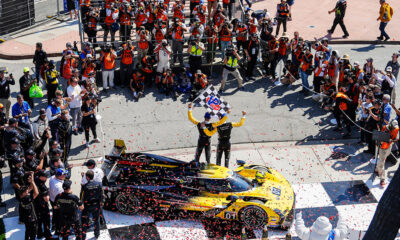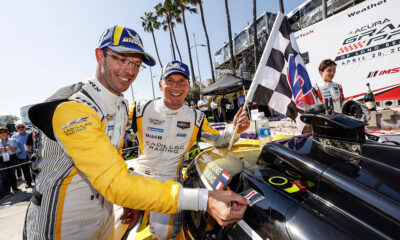John Edwards reckons the key to success at this year’s Motul Petit Le Mans will be about “minimizing the variables” in a race that is set to feature heavy traffic with a 43-car field.
With five classes in action, the grid for the 24th running of the annual 10-hour enduro at Michelin Raceway Road Atlanta is the largest since 2014.
Edwards, who shares the GT Le Mans pole-sitting No. 24 BMW M8 GTE with Jesse Krohn and Augusto Farfus, said that drivers in all categories will need to have patience and take care not to get caught up in incidents at the pinch points around the 2.54-mile lap.
The American driver noted that the need to minimize losses is similar to the approach a GT3 driver would take at the Nürburgring 24 in the face of thick traffic made up of multiple classes.
“It’s been very busy,” Edwards told Sportscar365. “We tested here with just a handful of cars and then you show up to the first practice and you can’t get a clean lap.
“It’s not surprising but it still somehow can frustrate you. By the time you go to the race it’s just about minimizing those loses.
“You’re not trying to post a lap time; you’re just trying to get through the traffic as quick as possible and have a better average than the guys around you.
“I’m looking forward to the variability. It kind of reminds me a bit of the Nürburgring when you have massive speed deltas and a ton of cars. You never have a clear lap at the Nürburgring: I just try to take that approach of doing a good average over the hour-long stint and that’s going to get you ahead of the competition.
“It’s not about maximizing every little piece of a lap when you’re on your own. It’s about minimizing the variables.”
Edwards explained that drivers at Petit will need to be comfortable with losing several seconds on a lap, based on the ebb and flow of picking up traffic at different locations.
“If you catch a car just before the Esses but you can’t stick a nose in and get by, you could easily lose a few seconds,” he said.
“You can have four and five-second swings across a lap if a prototype passes you into Turn 1 and another one into Turn 3 and you’re trying to pass a GT car, but you get stuck into the Esses.
“That stuff happens all the time and you lose four seconds to a guy who was ahead of you and didn’t have any of those issues.
“Then the next lap those same prototypes have to pass him. Maybe he gets lucky that time but next time he’s not. That’s the key is keeping calm in these types of races.
“It’s trying to deal with all of the variables without getting frustrated and maximize what you can maximize.”
M8 Showing “Much More Consistency” This Year
Edwards remarked that BMW M8 GTE has shown consistent pace across its practice stints in traffic, which is encouraging for the German manufacturer heading into the race.
At last year’s Petit Le Mans held earlier in mid-October, the best-placed BMW finished third behind the top entries from Porsche and Corvette Racing.
“The car balance has been really good so far,” Edwards explained.
“We tested here a couple of weeks ago and we were able to find some stuff that got the car a lot more drivable than we had last year.
“I would say it’s a similar ultimate pace but much more drivable. I think we have much more consistency, especially with the number of cars we have this weekend, traffic is a big topic.
“You have a car that’s fast but on a knife-edge it falls apart when you get in traffic and have to move off-line and change what you’re doing.
“For me getting that consistency with the same ultimate pace is definitely a positive. We’ll see. We’ve had some changes since last year BoP-wise and we have to see how all of that shakes out.”
A weather-watching Edwards astutely noted that race day conditions are set be cooler than last year, while the hours of darkness will be longer due to the event taking place after Daylight Savings Time ended last weekend.
“Last year we were competitive but we’re not really sure what we’re going to find in the race here,” he said. “It’s obviously a lot colder being a month later. I think the high is only 55 [F] on Saturday and half of the race is going to be at night.
“It will be around 40 degrees at the finish. I don’t think we’ve ever really run here in those types of temperatures. We normally test here in July or August when it’s very hot and it cools off by October for the race but it’s still quite warm during the day and cool at night.
“Now what we’re used to [in] that cool at night is going to be the high. Being a month later with the Daylight Savings Time we now have five hours of darkness. I think that’s going to be a huge shock to some guys that don’t have night experience.
“A lot of times, yes the race would finish at night but you could have your Pro guys in at night while the Am guy gets his minimum time done early.
“Now you’re going to have guys that need to drive at night that previously have never raced at night.
“I think that’s going to cause potentially a lot of issues in traffic and it’s going to make us have to be that much more careful to avoid an incident before the last hour or two of the race.”

























